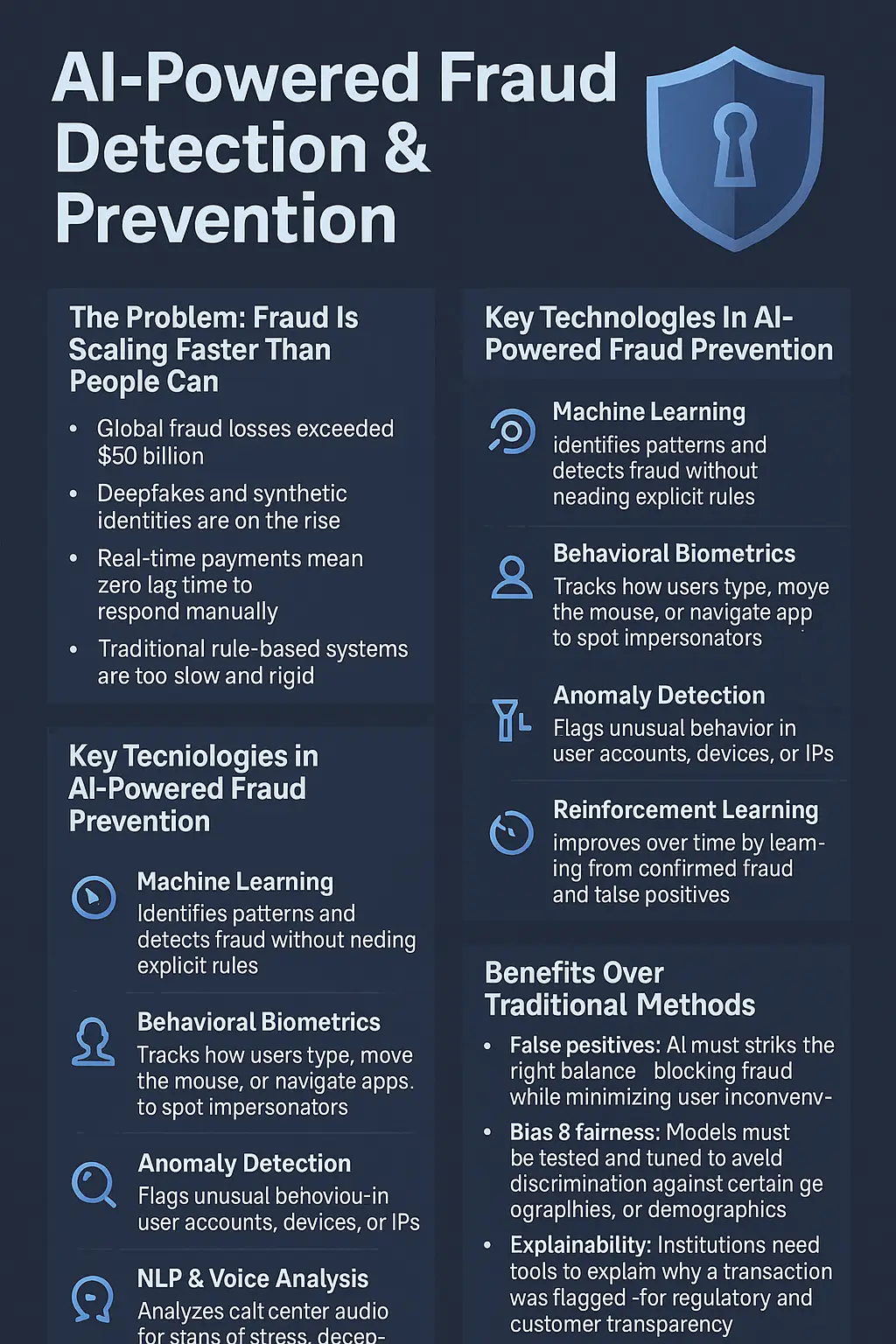🔐 AI-Powered Fraud Detection & Prevention: The New Defense in Digital Finance
In an increasingly digital and real-time financial world, fraud no longer moves in slow motion. It happens in milliseconds—across borders, platforms, and channels. In response, banks, fintechs, and payment processors are embracing a formidable new ally: AI-powered fraud detection and prevention.
AI is not only transforming how we detect fraud—it’s revolutionizing how we predict, prevent, and respond to it. This is more than an upgrade. It’s a necessary evolution for survival in the modern financial ecosystem.
⚠️ The Problem: Fraud Is Scaling Faster Than People Can
- In 2024, global fraud losses exceeded $50 billion
- Deepfakes and synthetic identities are on the rise
- Real-time payments mean zero lag time to respond manually
- Traditional rule-based systems are too slow and rigid
The volume, complexity, and speed of financial crime has outpaced the capacity of human teams and static fraud filters.
🤖 The Solution: AI-Powered Defense Systems
AI-powered fraud systems go far beyond keyword triggers or transaction thresholds. They:
- Analyze behavior across accounts in real time
- Detect anomalies invisible to rule-based systems
- Predict fraudulent intent before a transaction completes
- Respond autonomously—flagging, blocking, or escalating instantly
Machine learning models are trained on millions of transactions, constantly evolving to detect patterns of fraud—even as criminals change tactics.
🔍 Key Technologies in AI-Powered Fraud Prevention
| Technology | Role |
|---|---|
| 🧠 Machine Learning | Identifies patterns and detects fraud without needing explicit rules |
| 📍 Behavioral Biometrics | Tracks how users type, move the mouse, or navigate apps to spot impersonators |
| 🧬 Anomaly Detection | Flags unusual behavior in user accounts, devices, or IPs |
| 🔄 Reinforcement Learning | Improves over time by learning from confirmed fraud and false positives |
| 🔊 NLP & Voice Analysis | Analyzes call center audio for signs of stress, deception, or social engineering |
🛠️ Real-World Examples
- Bank of America uses AI to detect account takeovers by monitoring login device behavior.
- Stripe Radar prevents fraud in e-commerce by analyzing billions of global transaction patterns.
- PayPal uses machine learning to intercept suspicious login attempts before funds are accessed.
✅ Benefits Over Traditional Methods
| Traditional Fraud Detection | AI-Powered Fraud Prevention |
|---|---|
| Static rules | Adaptive intelligence |
| Manual review | Automated response |
| Delayed alerts | Real-time intervention |
| High false positives | Smart precision |
AI doesn’t just reduce fraud—it reduces friction for good customers, who no longer face unnecessary blocks or identity checks.
⚖️ Ethical & Operational Considerations
- False positives: AI must strike the right balance—blocking fraud while minimizing user inconvenience.
- Bias & fairness: Models must be tested and tuned to avoid discrimination against certain geographies or demographics.
- Explainability: Institutions need tools to explain why a transaction was flagged—for regulatory and customer transparency.
- Privacy: Behavioral data must be used responsibly, in line with GDPR and other global standards.
🚀 The Future: Autonomous Fraud Response Agents
Looking ahead, AI will not just detect fraud—it will:
- Negotiate with other agents in financial networks
- Adapt in real time to new types of attacks (e.g., AI-generated scams)
- Collaborate across institutions to create shared fraud intelligence ecosystems
“The next great financial security system won’t sit in a control room—it will be embedded in every transaction, powered by AI.”

